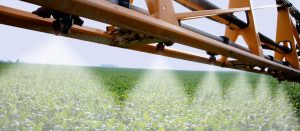Reducing off-target pesticide movement.
By Dusty Sonnenberg, CCA, Ohio Field Leader, a project of the Ohio Soybean Council and soybean check-off.
Simply put, one of the primary goals of a spray applicator is to get the product on the target. While this sounds relatively straight forward, there are a number of factors that come into play. According to Dr. Erdal Ozkan, Professor in the Department of Food, Agricultural and Biological Engineering at The Ohio State University, factors that significantly influence the off-target movement of pesticides include wind velocity and direction, spray droplet size and density, and the distance between the spray tip and the target. Other factors include the velocity and direction of the spray droplet, volatility of the product being sprayed, air temperature, relative humidity, and turbulence. At the end of the day, if the product does not reach the target, the pesticide application will not be effective, and there may even be a situation of off-target pesticide movement that can injure adjacent crops or landscape plants.

Chemical applicators need to make their best effort to control those things that are controllable. There are a few things that an applicator cannot control, however there are several factors that they can control to reduce off-target movement of pesticides.
Weather conditions cannot be controlled, but do need to be monitored, and necessary adjustments should be made if conditions change that would negatively affect the application process. Much research has been conducted regarding off-target movement of pesticides related to droplet size, wind velocity, also temperature and relative humidity.
The first thing that can be controlled is the ground speed of the application. “The first thing we need to do is to slow down,” said Ozkan. The slower the ground speed, the lower the boom pressure can be and the less likely there will be a large number of small spray droplets produced that are prone to drift.
Turbulence can cause off-target movement and can be caused by the spray equipment. Turbulence is caused by the movement of the boom and tires in field crop spraying. The faster the ground speed of the sprayer, the greater the turbulence behind the sprayer, and the greater likelihood of having an off-target (spray drift) situation. One solution to reduce the turbulence concern is to spray at a slower ground speed. Another solution is to use an air blast sprayer. With an air blast sprayer, the ground speed can be higher because spray droplets are unimpeded by turbulence caused by the sprayer chassis and instead are directed toward the target by forced air.
The second thing that can easily be controlled is to operate the sprayer at the proper boom height. This is another way to reduce the risk of off-target movement and improve spray application coverage. “Applicators need to get the boom as close to the target as possible without creating coverage issue,” said Ozkan. “Some nozzles need a certain amount of  space to create the proper overlap, however if the boom is too high, it does not improve overlap, but does increase the opportunity for off-target movement of the spray.”
space to create the proper overlap, however if the boom is too high, it does not improve overlap, but does increase the opportunity for off-target movement of the spray.”
Producing the proper spray droplet size can also mitigate off-target movement risk. Spray droplet size is a factor that can be controlled. “The reason there are several spray nozzles offered is because depending on the application, one may be more subject to drift risk than another one,” said Ozkan. “Without compromising the application rate or pressure, a nozzle can be selected that is going to reduce the portion of the spray that is coming out of the nozzle that is in small drift prone droplets. One nozzle operated at the same pressure may give a higher number of driftable droplets, where a different nozzle at the same pressure may have a much lower amount of driftable droplets.”
“Dr. Ozkan also suggests operating the sprayer at as low of a pressure as possible without sacrificing efficacy from the pesticide. This is especially true when spraying systemic herbicides because such products don’t require a thorough coverage of the target surface. However, contact type of herbicides, insecticides and fungicides do require a thorough coverage of the target surface which is difficult to achieve when using larger droplets. Therefore, in cases like that, and when drift risk is high, it may be better to rely on increasing the spray volume (not the active ingredient rate) to get the desired efficacy from the product. , a larger spray volume may be necessary, such as for a systemic product.
Always keep this in mind: a nozzle operated at a lower pressure will always provide relatively larger droplets that are less prone to drift. On the other side, by increasing the pressure, a given nozzle will produce more droplets that are smaller in diameter. By maintaining the pressure, the droplet size will remain constant. With automatic rate controllers, the pressure is typically adjusted and increased when ground speed increases to allow for the same volume of spray to cover the acreage being covered. This changes the droplet size.
Research has been conducted to determine the best droplet size to reduce the risk of drift under given conditions. Droplets the size of 50 microns in diameter or less are very likely to drift and be completely evaporated before they reach their intended target. According to research conducted by The Ohio State University, most nozzles used for applying pesticides produce a large portion of the spray volume in 100 micron diameter droplets and larger. The greater the diameter of the spray droplet, the less chance of drift or movement off-target.
The development and use of pulse width modulation (PWM) technology allows for a consistent droplet size to be applied, regardless of changes in ground speed and boom pressure. To understand how a PWM valve tip functions, it can be visualized like an old camera that adjusts the shutter speed (which dictates how long the shutter stays open) based on the amount of light required to get the exposure desired. The size of the PWM valve opening is fixed, but the length of time the valve is open will change (modulate) and pulsate. The “duty cycle” of the open time allows the pressure to be held constant going into the nozzle and thus the droplet size coming out of the tip will remain the same. Unlike a spray rate controller that simply adjusts pressure to the boom based on the ground speed, the PWM valve allows each nozzle to maintain the pressure going into the spray tip regardless of changes in ground speed or turns.
Detailed factsheets from The Ohio State University addressing off-target movement concerns include: Effects of Major Variables on Drift Distances and Spray Droplets, and also Selecting the Best Nozzle for the Job, as well as New Nozzles for Spray Drift Reduction.